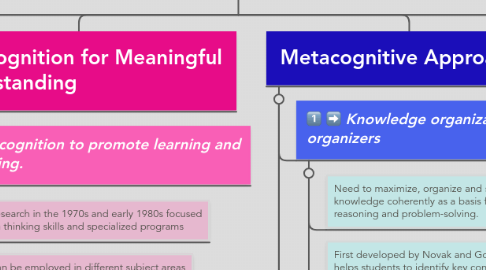
1. Classroom Questioning
1.1. A) Six levels of questions: Based on Bloom's Taxonomy.
1.1.1. Knowledge
1.1.2. Comprehension
1.1.2.1. Application
1.1.3. Analysis
1.1.4. Synthesis
1.1.5. Evaluation
1.2. B) Ask open-ended questions.
1.2.1. Initiate-Response-Evaluation (IRE)
1.2.1.1. Teacher asks a question, the student responds, and the teacher then provides feedback
1.2.2. Teacher still plays the dominant role in the classroom
1.2.2.1. students may turn high-level questions (analysis, synthesis) into routines, as they practice and drill them.
1.2.3. Students may turn high-level questions (analysis, synthesis) into routines, as they practice and drill them.
2. Developing Thinking Skills
2.1. Focuses on teaching thinking skills.
2.1.1. Develop critical thinking skills
2.1.1.1. develop critical thinking skills
2.1.2. The Philosophy for Children program, which was developed by Lipman (1985), asked children to read novels and then discuss philosophical issues
2.2. CORT is another popular program designed to develop creative thinking (de Bono, 1985).
2.2.1. 21st century education
2.2.2. Help students to develop the intellectual capacity to acquire and create knowledge as they develop a better understanding of the world.
2.3. 5 Dimensions of Learning to cultivate students’ thinking processes by Marzano and his colleagues (1993)
2.3.1. Develop a Positive Classroom Climate
2.3.2. Construct and Acquire Knowledge,
2.3.3. Refine Knowledge
2.3.4. Use Knowledge Meaningfully
2.3.5. Cultivate Habits of Mind.
3. Metacognition for Meaningful Understanding
3.1. Metacognition to promote learning and thinking.
3.1.1. Research in the 1970s and early 1980s focused on thinking skills and specialized programs
3.1.2. Can be employed in different subject areas with regular and special needs learners.
3.2. Metacognitive Prompts & Approaches
3.2.1. Knowledge organization and graphic organizers
3.2.2. Learning strategies and student-generated questions
3.2.3. Reflection and learning journals and diaries
3.2.4. Reading to learn and reciprocal teaching
3.2.5. Collaborative Inquiry and Knowledge Creation in Communities
3.2.6. From cooperative learning to collaborative inquiry
3.2.7. From collaborative inquiry to computer-supported knowledge-building
4. Metacognitive Approaches
4.1. Knowledge organization and graphic organizers
4.1.1. Need to maximize, organize and structure their knowledge coherently as a basis for developing reasoning and problem-solving.
4.1.2. First developed by Novak and Gowin (1984), helps students to identify key concepts and their relationships and to organize them into different hierarchies with meaningful links.
4.2. Learning strategies and student-generated questions
4.2.1. To foster higher-order thinking, teachers need to engage students in asking good questions themselves.
4.2.2. A common approach to student-generated questions is to ask ‘wh’ questions, although it is important that students include ‘why’ and ‘how’ questions, rather than only factual questions as ‘who,’ ‘when’, and ‘where.’
4.2.3. To encourage students to ask ‘wonderment’ questions that puzzle them to promote further inquiry.
4.2.4. Students should be encouraged to construct explanations to address their own questions and problems.
4.3. Reflection and learning journals and diaries
4.3.1. To ask students to write learning journals and diaries that reflect upon what they have learned.
4.3.2. Learning portfolios with learning diaries that include such questions and scaffolds as: (a) What is one most important point you have learned? and (b) What is one key question that you want to ask?
4.4. Reading to learn and reciprocal teaching
4.4.1. Reciprocal teaching involves students reading in groups. The reading is first led by the teacher and then by students, who take turns as the teacher, thus allowing students to take increased cognitive responsibility.
4.4.2. When they act as the teacher, they read using four key cognitive strategies – predicting, summarizing, clarifying and questioning – to help themselves and their classmates to understand the text.
4.4.3. Helps learners to develop the capacity to construct new understanding.
4.5. Collaborative Inquiry and Knowledge Creation in Communities
4.5.1. Learning and thinking seen as involving communication, interaction, and knowledge construction in group and community contexts.
4.6. From cooperative learning to collaborative inquiry
4.6.1. A distinction can be made between cooperation and collaboration – the former involves the division of labor to accomplish a task, the latter elicits a greater degree of higher-order thinking, as it pertains to collaborative problem-solving among team members, who tackle ill-structured problems, often with no known solution.
4.6.2. Instead of receiving information passively during lectures, students identify key learning issues that arise from problems; search for relevant information; develop hypotheses, theories and explanations; consider different viewpoints; summarize the key issues; and reflect on their learning.
4.7. From collaborative inquiry to computer-supported knowledge-building
4.7.1. Knowledge-building refers to students working collectively to create and improve ideas that add value to the community
4.7.2. To foster collaborative knowledge building by having students work together on computer-supported learning environments
5. What Is Higher-Order Thinking?
5.1. Cognitive activities, strategies, and habits of mind that go beyond regular and routine task-completion with the goal of deepening learning and understanding.
5.1.1. Critical thinking
5.1.1.1. critical thinking
5.1.2. Creative thinking
5.1.3. Focus on thinking processes
5.1.4. Metacognition
5.1.5. Collective thinking
5.1.6. Thinking that is situated in authentic contexts and learning communities.
5.1.7. To construct a meaningful understanding of the world
5.1.8. Technology-enhanced learning
6. Teacher Models for Higher-Order Thinking
6.1. Three teacher models can be considered for the teaching of higher-order thinking :
6.1.1. Teacher A is a routine and exercise model, whereby teachers provide information and students complete assigned tasks.
6.1.2. Teacher B is a model in which the teacher employs different pedagogical strategies to make the learning materials more meaningful.
6.1.3. Teacher C hands over the cognitive responsibility to the students, scaffolding them to take charge of their own learning. In this model, teachers are co-inquirers with students in understanding how thinking and learning can be fostered in the community.
